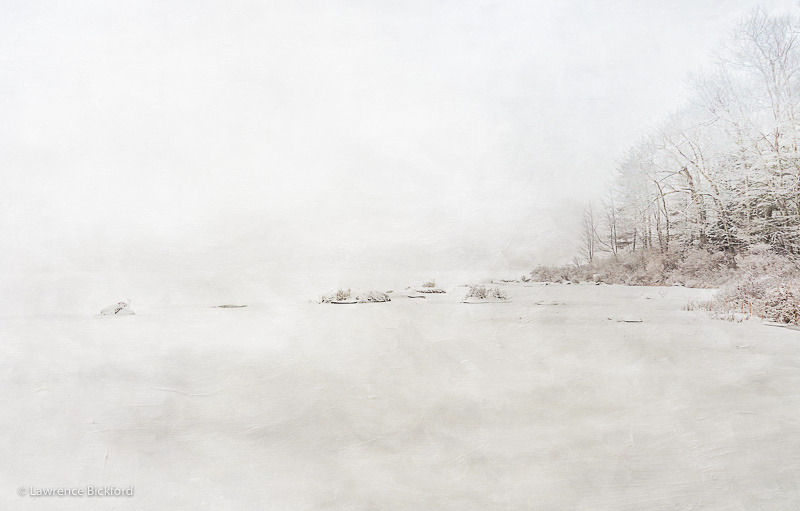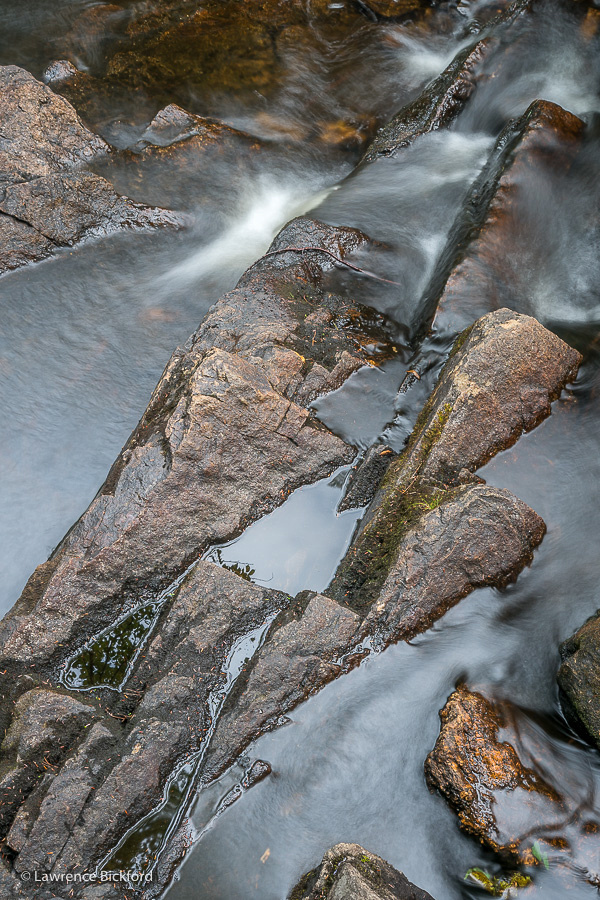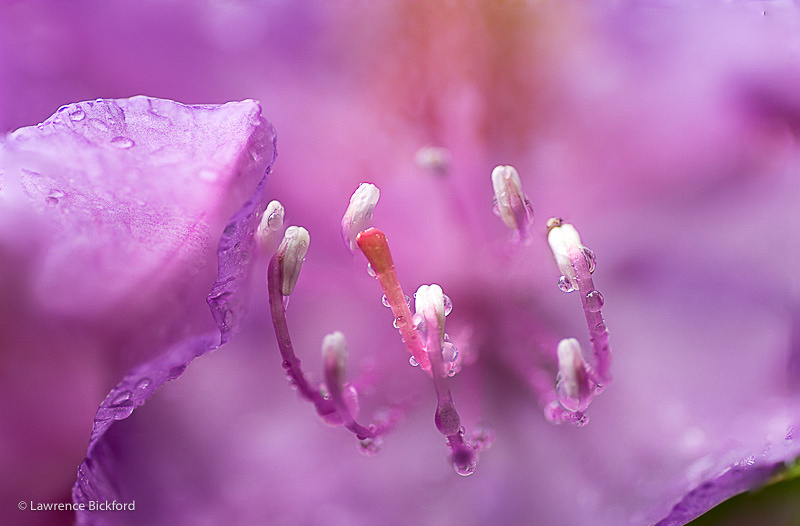
Being as close in as we are, depth of field is a major problem. I could get at most two stamens in focus at a time if I wanted the flower itself to be a blur of color. And of course that's exactly what I wanted. In my mind's eye, I saw the stamens rising out of a pink and orange fog. A very small aperture (say f/22) might have given me all of the stamens in focus, but then the blossom would have been in focus as well. Not what I had in mind. I wanted a focused foreground and a blur of a background.
So I used focus stacking. The final image as you see it here is composed of half a dozen shots, each taken with a different point of focus. The shots are then blended through the magic of Photoshop, which is able to select the in-focus portions of each shot and blend them into one image. Back in the day of film, I don't think this would have been possible, or if it was it would have been brutally difficult. But today's cameras are essentially computers attached to lenses. They open doors to focus stacking, exposure blending, color manipulation, cloning, and many other techniques that allow today's photographer to get closer and closer to that perfect image that lives only in the imagination.
]]>
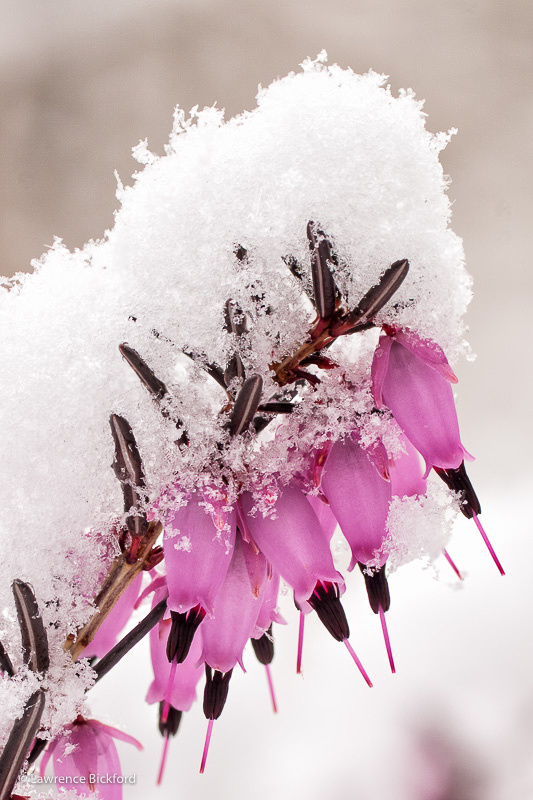
These blossoms are tiny -- certainly no bigger than a small kernel of corn. How to keep everything in focus? The "depth of field" -- the front-to-back distance of what's in focus -- was miniscule. An image like this relies on those many beautiful little details. What to do?
The answer is to use a nifty trick called focus stacking. The brief explanation is this: You take several photographs, each with a different aspect of the subject in focus, then let specialized software combine all of the in-focus areas into a single image. As the photograph above shows, the process is pretty much seamless and creates a realistic and honest image.
But wait! The eye sees the whole scene in focus. Why doesn't the camera? The short answer is that the eye seems to keep all the parts in focus, but the reality is that it shifts here and there, adjusting focus as it goes, and so creates the illusion of focus everywhere. In a sense, that's what focus stacking does as well.
On the day in question, I waited for the snowy breezes to die down, then took six or eight images, each focused on a different part of the scene. Photoshop then created the magic by combining the in-focus portions of each. And as a result, you see what I saw -- a twig carrying tiny little pink blossoms under a load of icy snow. Only in New Hampshire!
]]>The photograph by itself was very good but not great, mostly dark grey on light grey. I felt there was more tale here than the photo by itself could tell. My initial efforts in Photoshop seemed promising, but never quite what I wanted or what I saw in my mind's eye. To me, this image should be the embodiment of a cold New England winter, all frosty and grey and lonely, with snow and fog rolling in. Depressing, some might say.
The solution I found was to layer on some texture. The textures I chose were like brush strokes in oil. Somehow, they worked magic on the image. The ice on the pond went from a featureless near-white to a rolling, sea-like light grey. The sky is similarly sea-like, but lighter. The far shore remains a whisper, wrapped in fog. On the near shore, icy trees lean in to observe.
So now you ask, is it any longer a photograph? Is it dishonest to layer on textures? Is the objective truth of the photo gone?
Let's take the last one first. A photograph is not objective truth. Colors shift, distances expand and contract, focus changes. I could give you two different photos of this pond, taken on the same day and from the same spot, and ask you, how far is it across the pond? Depending on my choice of lenses, your two answers might be very different. I have seen portraits of young people whose skin tones apparently border on purple. Or green. Or orange. So much for objective truth.
Is it a photograph? The answer is, I think it is, but to be honest, I don't care. Is toast still toast if I put butter on it, or must I now say "buttered toast"? Must I call my creation a "textured photograph"? If I used Photoshop to remove a branch from the scene, does the work become a "Photoshopped photograph"? We're getting into trouble here. Let's just call it a photograph.
]]>What do you do with dark blue images? Delete them, process the heck out of them and turn them into something like daylight, or just forget about them. I just forgot about them. Until now. Revisiting the photos of this day in July, I wondered if the blue muddy images might become something more promising in black and white. Ah, the magic of black and white.
I made a copy of the image and started in. The quick way to create a black and white is to press one key. Presto! The color is gone and what remains is shades of grey. But the real route to black and white meanders down a long road filled with options. For example, there is a sliding control for exposure; it can lighten or darken the whole image depending on which way you slide it. I wanted lighter, so up it went. Another slider controls shadows (medium darks); up it went as well. Contrast, down a little. And so on through a couple dozen sliders, right down to the point where I could make the reds (what had been reds, now certain shades of grey) lighter or darker, the yellows lighter or darker, the blues lighter or darker. Lots of options means lots of control. And of course lots of time.
In the end, I arrived at this. It's a long way from the original image that came out of the camera, but in truth it's not all that far from what my eye saw that early morning. The light was low, the colors muted. Now the light has come up some and the colors are gone entirely, but the sense is similar. In the basin, little bits of foam race around, leaving white trails. Crossing their paths, the falls are mirrored in the basin.
I love the shattered rock wall with its cracks and diagonals. I love the way the stream sneaks around the top of the wall, then crashes down in a curtain of white water. I love the portion of the stream that takes the diagonal route along the wall. And I love the basin, on the one hand reflecting the main falls and on the other, making patterns with the bits of foam. The soft shimmer of the falling water contrasts beautifully with the hard-edged and fractured wall. Purgatory Falls is a spot I return to from time to time and never tire of shooting.
]]>
But just around the corner from the vertical wall was a merely steep climb. Not very high, but a little awkward with a camera and tripod. Still, up I went. This image gives a sense of the perspective. Looking down, the water was just deep enough, just shallow enough, to create the remarkable triangular rock forms you see here. Fascinating! I stayed up on my perch for probably an hour, exploring different angles and different shutter speeds. (This one is at 2 1/2 seconds, f/11, ISO 50. Polarized, but not fully; I wanted that grey-blue color of the water against the brown-gold rock. Processed in Lightroom, but not overly so. Probably could've used a little more, but I held back.)
Often, when I know a shoot has come up short, I get home and don't download the photos from the camera for days. I know if disappointment is in store. In this case, however, I was in a hurry to see what the camera had seen. And in this case, I was not let down. The new perspective, the shapes, the colors, everything worked as I had hoped. And all this goodness came about because I wanted a new angle on a familiar scene. There's no sense here of the familiar waterfall. In fact, there's no sense that there's a waterfall here at all. But no loss. The new perspective more than made up for skipping the old familiar.
]]>
Well, obviously, a lot of photographers care. I just don't happen to be one of them.
True story. I had the opportunity several years ago of shooting a very pretty young model with three other photographers. Two of us spent our time shooting the model, and the other two spent their afternoon gushing about cameras. I have a respectable camera and several lenses. Some of my lenses go back to film days, but so what? The bottom line for me is, what kind of images are we capturing with that gear? And what are we doing to get better?
Ansel Adams once said that a dozen significant images in one year is a pretty good harvest. So don't ask me what I'm shooting with. Ask me if I've done any significant work in the last month.
]]>
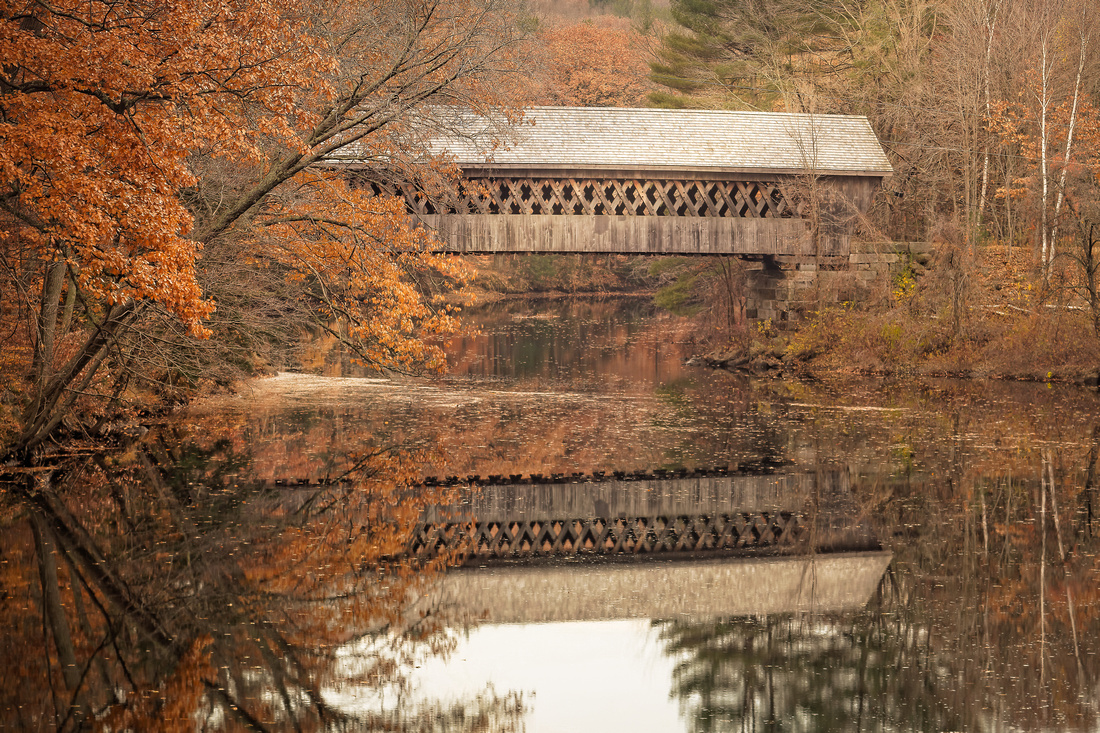 There's a richness in this image that wasn't in the original, thanks to the overlay of a texture file. "Texturing" is not my usual style, but once in a while an image comes along that just seems to cry out for that boost of color and push toward surrealism that a texture can provide. That was the case here. I took the file into Photoshop and applied a light coating of textures (two, I think, but maybe just one). The foliage sprang to life as it returned to that rich orange brown. I eased the texture at the bridge to give it a little pop against the November colors. And there it was, the image I remembered seeing that morning.
There's a richness in this image that wasn't in the original, thanks to the overlay of a texture file. "Texturing" is not my usual style, but once in a while an image comes along that just seems to cry out for that boost of color and push toward surrealism that a texture can provide. That was the case here. I took the file into Photoshop and applied a light coating of textures (two, I think, but maybe just one). The foliage sprang to life as it returned to that rich orange brown. I eased the texture at the bridge to give it a little pop against the November colors. And there it was, the image I remembered seeing that morning.
Funny that it took so much Photoshop magic to bring that flat, dull image back to the colorful image I recalled seeing. My usual inclination is to make simple adjustments to the straight-out-of-camera image to bring it in line with what I saw when I was shooting. I don't care for over-the-top colors and such; I want my images to look natural. That said, maybe I do like a "natural-plus" appearance, like the athletes who give 110% every day. I want my images at 110% of what I saw.
That's the case here, anyway. The application of texture brought the image to where I wanted it, at 110% of reality.
]]>
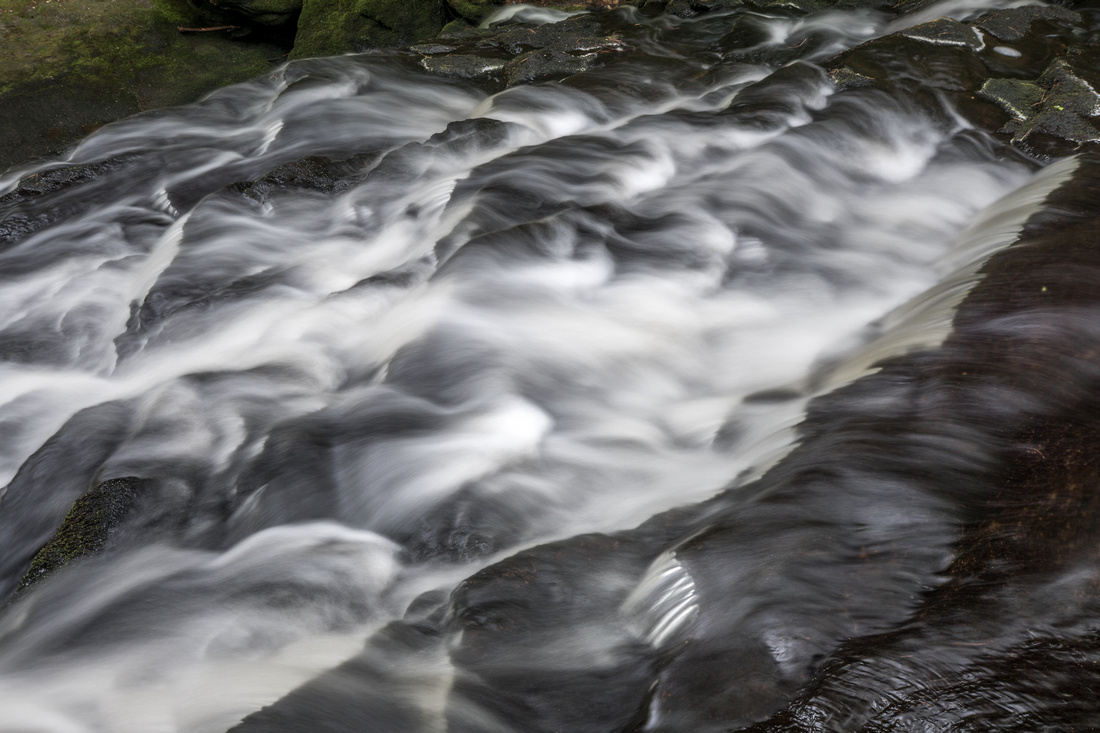 Shooting with a fast shutter speed, say 1/200 or more, stops the water and its droplets in their tracks. Especially in good light, this can yield stunning results as the glass-like sculpture flows past my lens. But it is just that glass-like quality that makes the image seem sculptural and static, not moving. Shooting with a slow shutter speed, say 15 seconds, turns water into a blur, into cotton candy, into a dreamy haze of flowing water. This can be beautiful also, but again is not what I want to show you.
Shooting with a fast shutter speed, say 1/200 or more, stops the water and its droplets in their tracks. Especially in good light, this can yield stunning results as the glass-like sculpture flows past my lens. But it is just that glass-like quality that makes the image seem sculptural and static, not moving. Shooting with a slow shutter speed, say 15 seconds, turns water into a blur, into cotton candy, into a dreamy haze of flowing water. This can be beautiful also, but again is not what I want to show you.
Somewhere in between, say between a half second and two seconds, is the sweet spot for me. It is there that I find the motion in the water that I'm looking for. The sculptural, glass-like quality is gone, and the water has not yet turned to haze. In the sweet spot, the water shows texture. Bright ribbons of water flow like muscles and sinews over dark rock. You see the flow, and you almost feel it.
This image, stream takes a tumble, was shot at 2 seconds, f/11, 28mm, looking down as a stream tumbles over rock and down a little falls. In Lightroom, I corrected the white balance (too green due to the overhead foliage), sharpened, adjust highlights and shadows, etc. for best presentation. The result is this chiaroscuro gem. 4 July 2015.
]]>
